DNA Plasmid Analysis and Digestion
VerifiedAdded on 2020/04/15
|19
|3826
|84
AI Summary
This assignment involves analyzing a gel electrophoresis image showing the results of different plasmid digestion experiments. Students need to identify specific bands corresponding to uncut, single-digested, and double-digested recombinant plasmids using their knowledge of DNA ladder markers and restriction enzyme activity. The analysis includes determining the size of digested fragments and comparing them to control samples.
Contribute Materials
Your contribution can guide someone’s learning journey. Share your
documents today.

Running head: GENETIC ENGINEERING
Course Code:
GENETIC ENGINEERING
Name of the Student:
Name of the Partner:
Name of TA:
Lab Section:
Report Submission Date:
Course Code:
GENETIC ENGINEERING
Name of the Student:
Name of the Partner:
Name of TA:
Lab Section:
Report Submission Date:
Secure Best Marks with AI Grader
Need help grading? Try our AI Grader for instant feedback on your assignments.

1GENETIC ENGINEERING
Abstract
The purpose of the study was to prepare a genomic DNA library. A genomic DNA library is created in
order to identify the DNA fragments or genes that are of interest to a researcher. The subsequent gene
cloned in the vector can be expressed to obtain the desired protein product. The genomic DNA library
was created by using the genomic DNA of Bacillus subtilis. The genomic DNA was isolated from the
organism and its concentration and purity were determined. Similarly, the plasmid DNA pUC18 was
used as the vector, which is required during cloning of the genomic DNA fragments into the vector.
The resulting genomic DNA and plasmid DNA were digested with two different restriction enzymes,
subsequently ligated and transformed into the Escherichia coli DH5α cells on X-gal/IPTG medium
containing plates. The ratio of blue to white colonies obtained were 3:8. The blue colonies did not
contain the inserts obtained from genomic DNA, while the white colonies carried the recombinant
DNA having desired inserts obtained from genomic DNA ligated to the vector pUC18. The
recombinant plasmids were isolated from the desired white colored clones and subjected to double
digestion with the same restriction enzymes, which were used to digest the plasmid and the genomic
DNA. Double digestion yielded the desired insert and the vector, which in this case is pUC18. Single
digestion of recombinant plasmid and vector showed the desired shift due to the differences in size
resulting from the presence of the insert in the plasmid DNA. Thus, cloning was successful as the
desired recombinant clones carrying the genomic DNA insert was obtained.
Abstract
The purpose of the study was to prepare a genomic DNA library. A genomic DNA library is created in
order to identify the DNA fragments or genes that are of interest to a researcher. The subsequent gene
cloned in the vector can be expressed to obtain the desired protein product. The genomic DNA library
was created by using the genomic DNA of Bacillus subtilis. The genomic DNA was isolated from the
organism and its concentration and purity were determined. Similarly, the plasmid DNA pUC18 was
used as the vector, which is required during cloning of the genomic DNA fragments into the vector.
The resulting genomic DNA and plasmid DNA were digested with two different restriction enzymes,
subsequently ligated and transformed into the Escherichia coli DH5α cells on X-gal/IPTG medium
containing plates. The ratio of blue to white colonies obtained were 3:8. The blue colonies did not
contain the inserts obtained from genomic DNA, while the white colonies carried the recombinant
DNA having desired inserts obtained from genomic DNA ligated to the vector pUC18. The
recombinant plasmids were isolated from the desired white colored clones and subjected to double
digestion with the same restriction enzymes, which were used to digest the plasmid and the genomic
DNA. Double digestion yielded the desired insert and the vector, which in this case is pUC18. Single
digestion of recombinant plasmid and vector showed the desired shift due to the differences in size
resulting from the presence of the insert in the plasmid DNA. Thus, cloning was successful as the
desired recombinant clones carrying the genomic DNA insert was obtained.
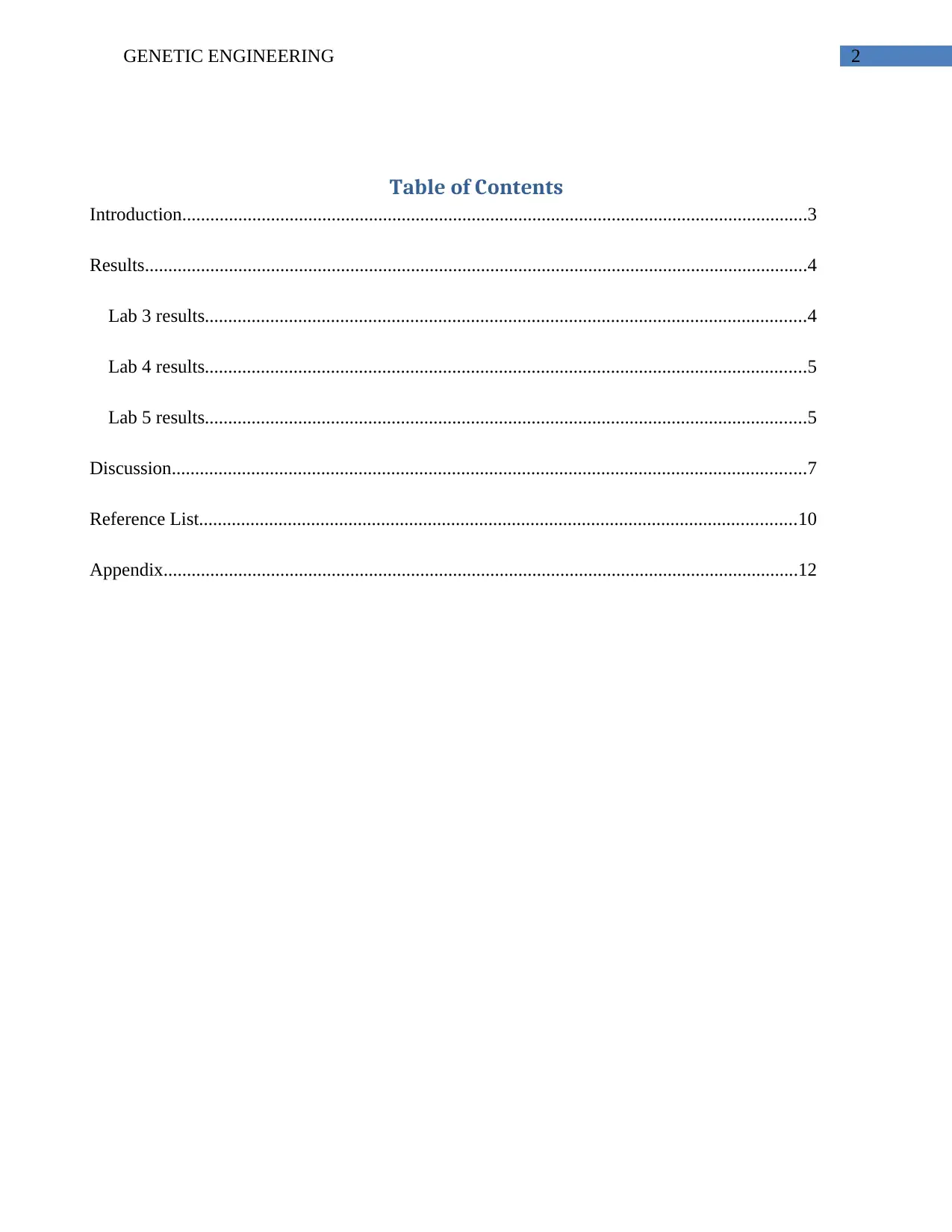
2GENETIC ENGINEERING
Table of Contents
Introduction......................................................................................................................................3
Results..............................................................................................................................................4
Lab 3 results.................................................................................................................................4
Lab 4 results.................................................................................................................................5
Lab 5 results.................................................................................................................................5
Discussion........................................................................................................................................7
Reference List................................................................................................................................10
Appendix........................................................................................................................................12
Table of Contents
Introduction......................................................................................................................................3
Results..............................................................................................................................................4
Lab 3 results.................................................................................................................................4
Lab 4 results.................................................................................................................................5
Lab 5 results.................................................................................................................................5
Discussion........................................................................................................................................7
Reference List................................................................................................................................10
Appendix........................................................................................................................................12
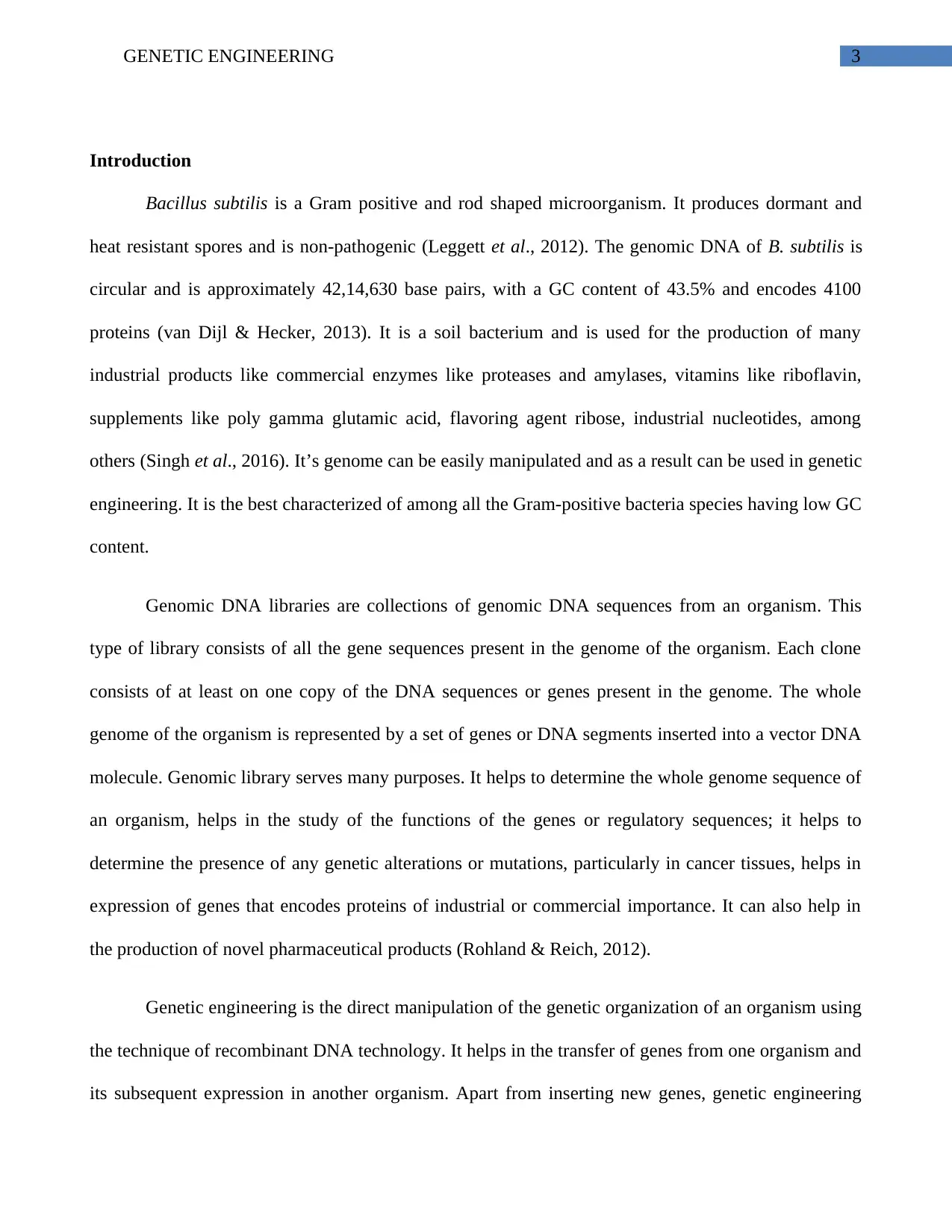
3GENETIC ENGINEERING
Introduction
Bacillus subtilis is a Gram positive and rod shaped microorganism. It produces dormant and
heat resistant spores and is non-pathogenic (Leggett et al., 2012). The genomic DNA of B. subtilis is
circular and is approximately 42,14,630 base pairs, with a GC content of 43.5% and encodes 4100
proteins (van Dijl & Hecker, 2013). It is a soil bacterium and is used for the production of many
industrial products like commercial enzymes like proteases and amylases, vitamins like riboflavin,
supplements like poly gamma glutamic acid, flavoring agent ribose, industrial nucleotides, among
others (Singh et al., 2016). It’s genome can be easily manipulated and as a result can be used in genetic
engineering. It is the best characterized of among all the Gram-positive bacteria species having low GC
content.
Genomic DNA libraries are collections of genomic DNA sequences from an organism. This
type of library consists of all the gene sequences present in the genome of the organism. Each clone
consists of at least on one copy of the DNA sequences or genes present in the genome. The whole
genome of the organism is represented by a set of genes or DNA segments inserted into a vector DNA
molecule. Genomic library serves many purposes. It helps to determine the whole genome sequence of
an organism, helps in the study of the functions of the genes or regulatory sequences; it helps to
determine the presence of any genetic alterations or mutations, particularly in cancer tissues, helps in
expression of genes that encodes proteins of industrial or commercial importance. It can also help in
the production of novel pharmaceutical products (Rohland & Reich, 2012).
Genetic engineering is the direct manipulation of the genetic organization of an organism using
the technique of recombinant DNA technology. It helps in the transfer of genes from one organism and
its subsequent expression in another organism. Apart from inserting new genes, genetic engineering
Introduction
Bacillus subtilis is a Gram positive and rod shaped microorganism. It produces dormant and
heat resistant spores and is non-pathogenic (Leggett et al., 2012). The genomic DNA of B. subtilis is
circular and is approximately 42,14,630 base pairs, with a GC content of 43.5% and encodes 4100
proteins (van Dijl & Hecker, 2013). It is a soil bacterium and is used for the production of many
industrial products like commercial enzymes like proteases and amylases, vitamins like riboflavin,
supplements like poly gamma glutamic acid, flavoring agent ribose, industrial nucleotides, among
others (Singh et al., 2016). It’s genome can be easily manipulated and as a result can be used in genetic
engineering. It is the best characterized of among all the Gram-positive bacteria species having low GC
content.
Genomic DNA libraries are collections of genomic DNA sequences from an organism. This
type of library consists of all the gene sequences present in the genome of the organism. Each clone
consists of at least on one copy of the DNA sequences or genes present in the genome. The whole
genome of the organism is represented by a set of genes or DNA segments inserted into a vector DNA
molecule. Genomic library serves many purposes. It helps to determine the whole genome sequence of
an organism, helps in the study of the functions of the genes or regulatory sequences; it helps to
determine the presence of any genetic alterations or mutations, particularly in cancer tissues, helps in
expression of genes that encodes proteins of industrial or commercial importance. It can also help in
the production of novel pharmaceutical products (Rohland & Reich, 2012).
Genetic engineering is the direct manipulation of the genetic organization of an organism using
the technique of recombinant DNA technology. It helps in the transfer of genes from one organism and
its subsequent expression in another organism. Apart from inserting new genes, genetic engineering
Secure Best Marks with AI Grader
Need help grading? Try our AI Grader for instant feedback on your assignments.

4GENETIC ENGINEERING
also involves the mutation of knocking out of genes in an organism. Genetically modified organisms,
particularly bacteria have been used in the past to produce insulin, human growth hormone, industrial
enzymes that are used in laundry detergents, among others. This technique has also been used for the
production of genetically modified crops or GMOs (Nielsen, 2013). The overall purpose of this report
is “to create a genomic DNA library using the genome of the organism B. subtilis, followed by its
subsequent confirmation steps to determine success of the process”.
Results
Lab 3 results
The genomic DNA of B. subtilis that was isolated during Lab 2 were used for the subsequent
cloning steps. The concentration of the genomic DNA was 44ng/μl. The isolated genomic DNA was
used to create the recombinant plasmids present in the genomic DNA library. The genomic DNA was
digested with the restriction enzymes EcoRI and HindIII to yield the different DNA fragments or
inserts that will be ligated to the similarly digested plasmid DNA vector (pUC18) to create
recombinant plasmids that are transformed into the Escherichia coli DH5α cells. The samples
subjected to restriction digestion were incubated at 37ºC for 1 hour, followed by incubation at 80 ºC
for 10 minutes to inactivate the restriction enzymes. The respective digestion products of the genomic
DNA and plasmid DNA were subjected to ligation. For this, the sample was incubated at 45 ºC to
denature the reannealed digested products, followed by ligation at 18 ºC for 30 minutes. The ligation
reaction was then incubated at 65 ºC for 10 minutes. The ligated products were subsequently
transformed into E. coli DH5α cells. The transformants were plated on LB agar plates containing X-
gal, IPTG and Ampicillin.
also involves the mutation of knocking out of genes in an organism. Genetically modified organisms,
particularly bacteria have been used in the past to produce insulin, human growth hormone, industrial
enzymes that are used in laundry detergents, among others. This technique has also been used for the
production of genetically modified crops or GMOs (Nielsen, 2013). The overall purpose of this report
is “to create a genomic DNA library using the genome of the organism B. subtilis, followed by its
subsequent confirmation steps to determine success of the process”.
Results
Lab 3 results
The genomic DNA of B. subtilis that was isolated during Lab 2 were used for the subsequent
cloning steps. The concentration of the genomic DNA was 44ng/μl. The isolated genomic DNA was
used to create the recombinant plasmids present in the genomic DNA library. The genomic DNA was
digested with the restriction enzymes EcoRI and HindIII to yield the different DNA fragments or
inserts that will be ligated to the similarly digested plasmid DNA vector (pUC18) to create
recombinant plasmids that are transformed into the Escherichia coli DH5α cells. The samples
subjected to restriction digestion were incubated at 37ºC for 1 hour, followed by incubation at 80 ºC
for 10 minutes to inactivate the restriction enzymes. The respective digestion products of the genomic
DNA and plasmid DNA were subjected to ligation. For this, the sample was incubated at 45 ºC to
denature the reannealed digested products, followed by ligation at 18 ºC for 30 minutes. The ligation
reaction was then incubated at 65 ºC for 10 minutes. The ligated products were subsequently
transformed into E. coli DH5α cells. The transformants were plated on LB agar plates containing X-
gal, IPTG and Ampicillin.
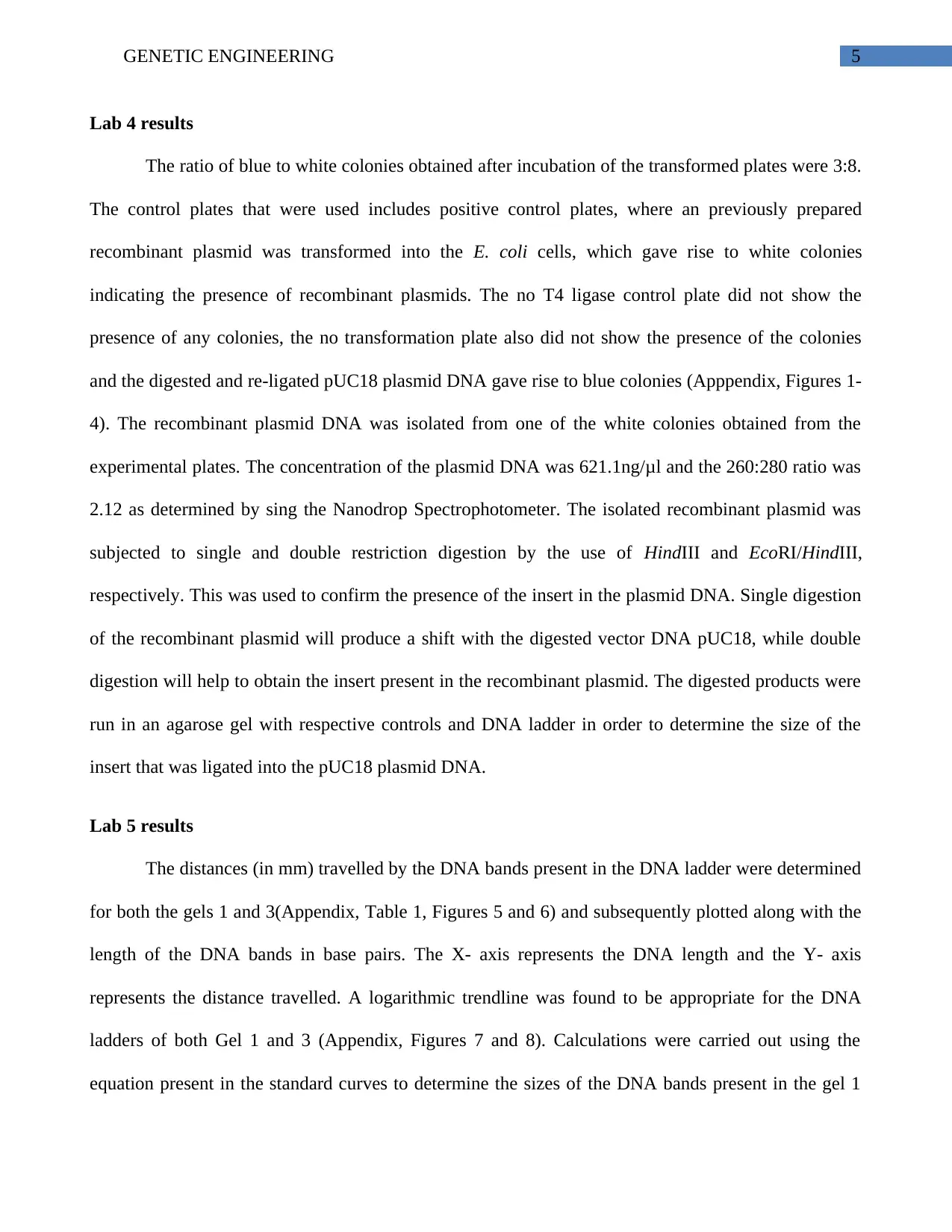
5GENETIC ENGINEERING
Lab 4 results
The ratio of blue to white colonies obtained after incubation of the transformed plates were 3:8.
The control plates that were used includes positive control plates, where an previously prepared
recombinant plasmid was transformed into the E. coli cells, which gave rise to white colonies
indicating the presence of recombinant plasmids. The no T4 ligase control plate did not show the
presence of any colonies, the no transformation plate also did not show the presence of the colonies
and the digested and re-ligated pUC18 plasmid DNA gave rise to blue colonies (Apppendix, Figures 1-
4). The recombinant plasmid DNA was isolated from one of the white colonies obtained from the
experimental plates. The concentration of the plasmid DNA was 621.1ng/μl and the 260:280 ratio was
2.12 as determined by sing the Nanodrop Spectrophotometer. The isolated recombinant plasmid was
subjected to single and double restriction digestion by the use of HindIII and EcoRI/HindIII,
respectively. This was used to confirm the presence of the insert in the plasmid DNA. Single digestion
of the recombinant plasmid will produce a shift with the digested vector DNA pUC18, while double
digestion will help to obtain the insert present in the recombinant plasmid. The digested products were
run in an agarose gel with respective controls and DNA ladder in order to determine the size of the
insert that was ligated into the pUC18 plasmid DNA.
Lab 5 results
The distances (in mm) travelled by the DNA bands present in the DNA ladder were determined
for both the gels 1 and 3(Appendix, Table 1, Figures 5 and 6) and subsequently plotted along with the
length of the DNA bands in base pairs. The X- axis represents the DNA length and the Y- axis
represents the distance travelled. A logarithmic trendline was found to be appropriate for the DNA
ladders of both Gel 1 and 3 (Appendix, Figures 7 and 8). Calculations were carried out using the
equation present in the standard curves to determine the sizes of the DNA bands present in the gel 1
Lab 4 results
The ratio of blue to white colonies obtained after incubation of the transformed plates were 3:8.
The control plates that were used includes positive control plates, where an previously prepared
recombinant plasmid was transformed into the E. coli cells, which gave rise to white colonies
indicating the presence of recombinant plasmids. The no T4 ligase control plate did not show the
presence of any colonies, the no transformation plate also did not show the presence of the colonies
and the digested and re-ligated pUC18 plasmid DNA gave rise to blue colonies (Apppendix, Figures 1-
4). The recombinant plasmid DNA was isolated from one of the white colonies obtained from the
experimental plates. The concentration of the plasmid DNA was 621.1ng/μl and the 260:280 ratio was
2.12 as determined by sing the Nanodrop Spectrophotometer. The isolated recombinant plasmid was
subjected to single and double restriction digestion by the use of HindIII and EcoRI/HindIII,
respectively. This was used to confirm the presence of the insert in the plasmid DNA. Single digestion
of the recombinant plasmid will produce a shift with the digested vector DNA pUC18, while double
digestion will help to obtain the insert present in the recombinant plasmid. The digested products were
run in an agarose gel with respective controls and DNA ladder in order to determine the size of the
insert that was ligated into the pUC18 plasmid DNA.
Lab 5 results
The distances (in mm) travelled by the DNA bands present in the DNA ladder were determined
for both the gels 1 and 3(Appendix, Table 1, Figures 5 and 6) and subsequently plotted along with the
length of the DNA bands in base pairs. The X- axis represents the DNA length and the Y- axis
represents the distance travelled. A logarithmic trendline was found to be appropriate for the DNA
ladders of both Gel 1 and 3 (Appendix, Figures 7 and 8). Calculations were carried out using the
equation present in the standard curves to determine the sizes of the DNA bands present in the gel 1

6GENETIC ENGINEERING
(control samples, Figure 5) and gel 3 (Experimental gel, Figure 6). The sizes of the DNA bands are
provided in Table 2 (Appendix).
In gel 1, the uncut pUC 18 had three bands of sizes 8103, 3827 and 2980bp, respectively. The
double digested pUC18 and the control genomic DNA had one band of sizes approximately 2697bp
and 12088bp, respectively. The control uncut, single digested and double digested recombinant
plasmid had two bands each of sizes approximately 4447.1 and 2208.3bp, 2697 and 735bp, 2697 and
665.1bp, respectively (Appendix, Figure 5). In gel 3, the genomic DNA, uncut and single digested
recombinant DNA had only one band of sizes approximately 13359bp, 3640bp and 3400bp,
respectively. The double digested recombinant DNA had two bands of sizes approximately 2697bp and
692bp, respectively. The foreign DNA insert obtained after double digestion of the recombinant
plasmid with EcoRI/HindIII was approximately 692bp (Appendix, Figure 6). While the single digested
product was 3400bp approximately, the sizes of the DNA bands in the double digested product adds up
to 3389bp, which is more or less the same as the DNA size obtained in the case of single digestion.
The single digestion of the control recombinant plasmid yielded two bands, while the single digestion
of the experimental recombinant plasmid yielded one band (Appendix, Figures 5 and 6).
Discussion
The aim of this report was to generate a genomic DNA library. For this, the genomic DNA of
B. subtilis and pUC18 plasmid DNA were digested and ligated. Transformants obtained showed that
the ratio of the blue to white colonies were 3:8. Thus, the number of clones containing recombinant
plasmids were much higher than the clones carrying the empty vector pUC18. Therefore, maximum
number of inserts obtained after digestion of the genomic DNA had undergone ligation with the
similarly digested plasmid DNA supporting the success of the experiment. The white colonies were
(control samples, Figure 5) and gel 3 (Experimental gel, Figure 6). The sizes of the DNA bands are
provided in Table 2 (Appendix).
In gel 1, the uncut pUC 18 had three bands of sizes 8103, 3827 and 2980bp, respectively. The
double digested pUC18 and the control genomic DNA had one band of sizes approximately 2697bp
and 12088bp, respectively. The control uncut, single digested and double digested recombinant
plasmid had two bands each of sizes approximately 4447.1 and 2208.3bp, 2697 and 735bp, 2697 and
665.1bp, respectively (Appendix, Figure 5). In gel 3, the genomic DNA, uncut and single digested
recombinant DNA had only one band of sizes approximately 13359bp, 3640bp and 3400bp,
respectively. The double digested recombinant DNA had two bands of sizes approximately 2697bp and
692bp, respectively. The foreign DNA insert obtained after double digestion of the recombinant
plasmid with EcoRI/HindIII was approximately 692bp (Appendix, Figure 6). While the single digested
product was 3400bp approximately, the sizes of the DNA bands in the double digested product adds up
to 3389bp, which is more or less the same as the DNA size obtained in the case of single digestion.
The single digestion of the control recombinant plasmid yielded two bands, while the single digestion
of the experimental recombinant plasmid yielded one band (Appendix, Figures 5 and 6).
Discussion
The aim of this report was to generate a genomic DNA library. For this, the genomic DNA of
B. subtilis and pUC18 plasmid DNA were digested and ligated. Transformants obtained showed that
the ratio of the blue to white colonies were 3:8. Thus, the number of clones containing recombinant
plasmids were much higher than the clones carrying the empty vector pUC18. Therefore, maximum
number of inserts obtained after digestion of the genomic DNA had undergone ligation with the
similarly digested plasmid DNA supporting the success of the experiment. The white colonies were
Paraphrase This Document
Need a fresh take? Get an instant paraphrase of this document with our AI Paraphraser

7GENETIC ENGINEERING
obtained as a result of disruption of the lacZ gene present in the multiple cloning site (MCS) of the
vector. However, some single digested vectors were present that gave rise to the blue colonies, since
the lacZ gene remained intact and utilized the X-gal substrate to produce the blue color. Moreover, the
recombinant plasmid obtained was confirmed by double digestion, which yielded DNA bands of sizes
2697 and 692 bp. These two are the sizes of the vector pUC18 (2697bp) and the foreign DNA insert
(692bp). Moreover, the single digested product gave a single DNA band of size 3400bp, which is the
same when the sizes of the double digested products are added up. The sizes of the DNA bands
obtained after digestion of the control recombinant plasmids indicated that the parent plasmid here was
also pUC18. Moreover, the single digestion of this control recombinant plasmid revealed that the
enzyme used had two sites, thereby giving rise to two bands, like that in the case of double digestion,
however the sizes of the inserts obtained in both the cases were slightly different.
The problems that were encountered in the process were no colonies were obtained in the
experimental plate. This result could be due to the presence of various discrepancies. These include:
(1) improper purification during genomic and plasmid DNA preparation. Presence of ethanol, phenol
and chloroform can inhibit or interfere with restriction digestion (Naushad et al., 2012). (2) Improper
inactivation of restriction enzymes can interfere with the subsequent ligation steps, preventing
successful ligation. (3) Inappropriate preparation of competent cells can also prevent the uptake of the
recombinant DNA, thereby preventing the appearance of colonies on the plates (O'Connell, 2012). (4)
Star activity can cause the DNA could be cut at non-specific sites by the restriction enzymes (Lundin
et al., 2015). Other odd results that were obtained is the presence of blue colonies in the experimental
plate and the presence of white colonies in the pUC 18 control plates. The blue colonies in the
experimental plate indicates the presence of single digested or undigested plasmid vectors that have re-
ligated, even after incubation at 45ºC to denature the reannealed products. This may be due to
obtained as a result of disruption of the lacZ gene present in the multiple cloning site (MCS) of the
vector. However, some single digested vectors were present that gave rise to the blue colonies, since
the lacZ gene remained intact and utilized the X-gal substrate to produce the blue color. Moreover, the
recombinant plasmid obtained was confirmed by double digestion, which yielded DNA bands of sizes
2697 and 692 bp. These two are the sizes of the vector pUC18 (2697bp) and the foreign DNA insert
(692bp). Moreover, the single digested product gave a single DNA band of size 3400bp, which is the
same when the sizes of the double digested products are added up. The sizes of the DNA bands
obtained after digestion of the control recombinant plasmids indicated that the parent plasmid here was
also pUC18. Moreover, the single digestion of this control recombinant plasmid revealed that the
enzyme used had two sites, thereby giving rise to two bands, like that in the case of double digestion,
however the sizes of the inserts obtained in both the cases were slightly different.
The problems that were encountered in the process were no colonies were obtained in the
experimental plate. This result could be due to the presence of various discrepancies. These include:
(1) improper purification during genomic and plasmid DNA preparation. Presence of ethanol, phenol
and chloroform can inhibit or interfere with restriction digestion (Naushad et al., 2012). (2) Improper
inactivation of restriction enzymes can interfere with the subsequent ligation steps, preventing
successful ligation. (3) Inappropriate preparation of competent cells can also prevent the uptake of the
recombinant DNA, thereby preventing the appearance of colonies on the plates (O'Connell, 2012). (4)
Star activity can cause the DNA could be cut at non-specific sites by the restriction enzymes (Lundin
et al., 2015). Other odd results that were obtained is the presence of blue colonies in the experimental
plate and the presence of white colonies in the pUC 18 control plates. The blue colonies in the
experimental plate indicates the presence of single digested or undigested plasmid vectors that have re-
ligated, even after incubation at 45ºC to denature the reannealed products. This may be due to
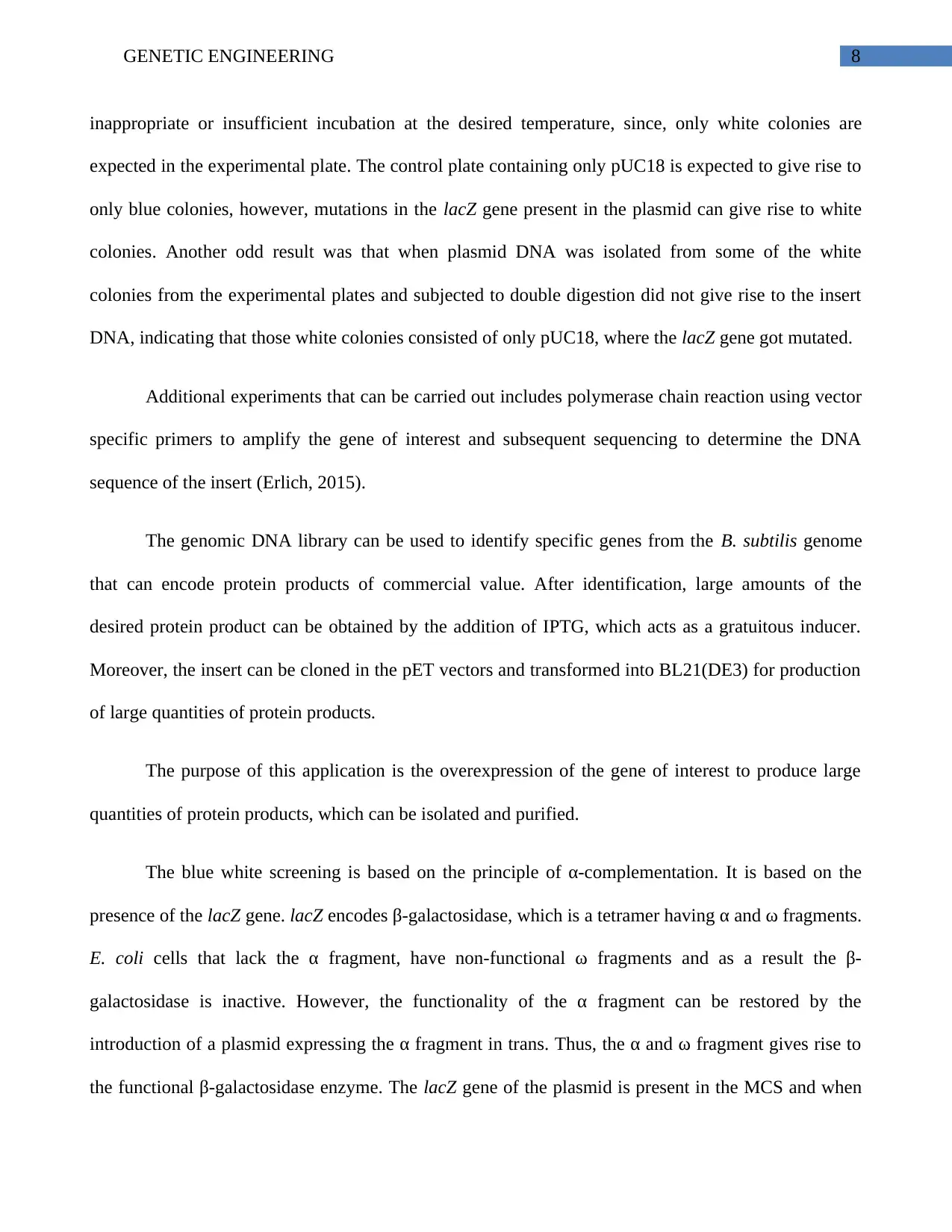
8GENETIC ENGINEERING
inappropriate or insufficient incubation at the desired temperature, since, only white colonies are
expected in the experimental plate. The control plate containing only pUC18 is expected to give rise to
only blue colonies, however, mutations in the lacZ gene present in the plasmid can give rise to white
colonies. Another odd result was that when plasmid DNA was isolated from some of the white
colonies from the experimental plates and subjected to double digestion did not give rise to the insert
DNA, indicating that those white colonies consisted of only pUC18, where the lacZ gene got mutated.
Additional experiments that can be carried out includes polymerase chain reaction using vector
specific primers to amplify the gene of interest and subsequent sequencing to determine the DNA
sequence of the insert (Erlich, 2015).
The genomic DNA library can be used to identify specific genes from the B. subtilis genome
that can encode protein products of commercial value. After identification, large amounts of the
desired protein product can be obtained by the addition of IPTG, which acts as a gratuitous inducer.
Moreover, the insert can be cloned in the pET vectors and transformed into BL21(DE3) for production
of large quantities of protein products.
The purpose of this application is the overexpression of the gene of interest to produce large
quantities of protein products, which can be isolated and purified.
The blue white screening is based on the principle of α-complementation. It is based on the
presence of the lacZ gene. lacZ encodes β-galactosidase, which is a tetramer having α and ω fragments.
E. coli cells that lack the α fragment, have non-functional ω fragments and as a result the β-
galactosidase is inactive. However, the functionality of the α fragment can be restored by the
introduction of a plasmid expressing the α fragment in trans. Thus, the α and ω fragment gives rise to
the functional β-galactosidase enzyme. The lacZ gene of the plasmid is present in the MCS and when
inappropriate or insufficient incubation at the desired temperature, since, only white colonies are
expected in the experimental plate. The control plate containing only pUC18 is expected to give rise to
only blue colonies, however, mutations in the lacZ gene present in the plasmid can give rise to white
colonies. Another odd result was that when plasmid DNA was isolated from some of the white
colonies from the experimental plates and subjected to double digestion did not give rise to the insert
DNA, indicating that those white colonies consisted of only pUC18, where the lacZ gene got mutated.
Additional experiments that can be carried out includes polymerase chain reaction using vector
specific primers to amplify the gene of interest and subsequent sequencing to determine the DNA
sequence of the insert (Erlich, 2015).
The genomic DNA library can be used to identify specific genes from the B. subtilis genome
that can encode protein products of commercial value. After identification, large amounts of the
desired protein product can be obtained by the addition of IPTG, which acts as a gratuitous inducer.
Moreover, the insert can be cloned in the pET vectors and transformed into BL21(DE3) for production
of large quantities of protein products.
The purpose of this application is the overexpression of the gene of interest to produce large
quantities of protein products, which can be isolated and purified.
The blue white screening is based on the principle of α-complementation. It is based on the
presence of the lacZ gene. lacZ encodes β-galactosidase, which is a tetramer having α and ω fragments.
E. coli cells that lack the α fragment, have non-functional ω fragments and as a result the β-
galactosidase is inactive. However, the functionality of the α fragment can be restored by the
introduction of a plasmid expressing the α fragment in trans. Thus, the α and ω fragment gives rise to
the functional β-galactosidase enzyme. The lacZ gene of the plasmid is present in the MCS and when
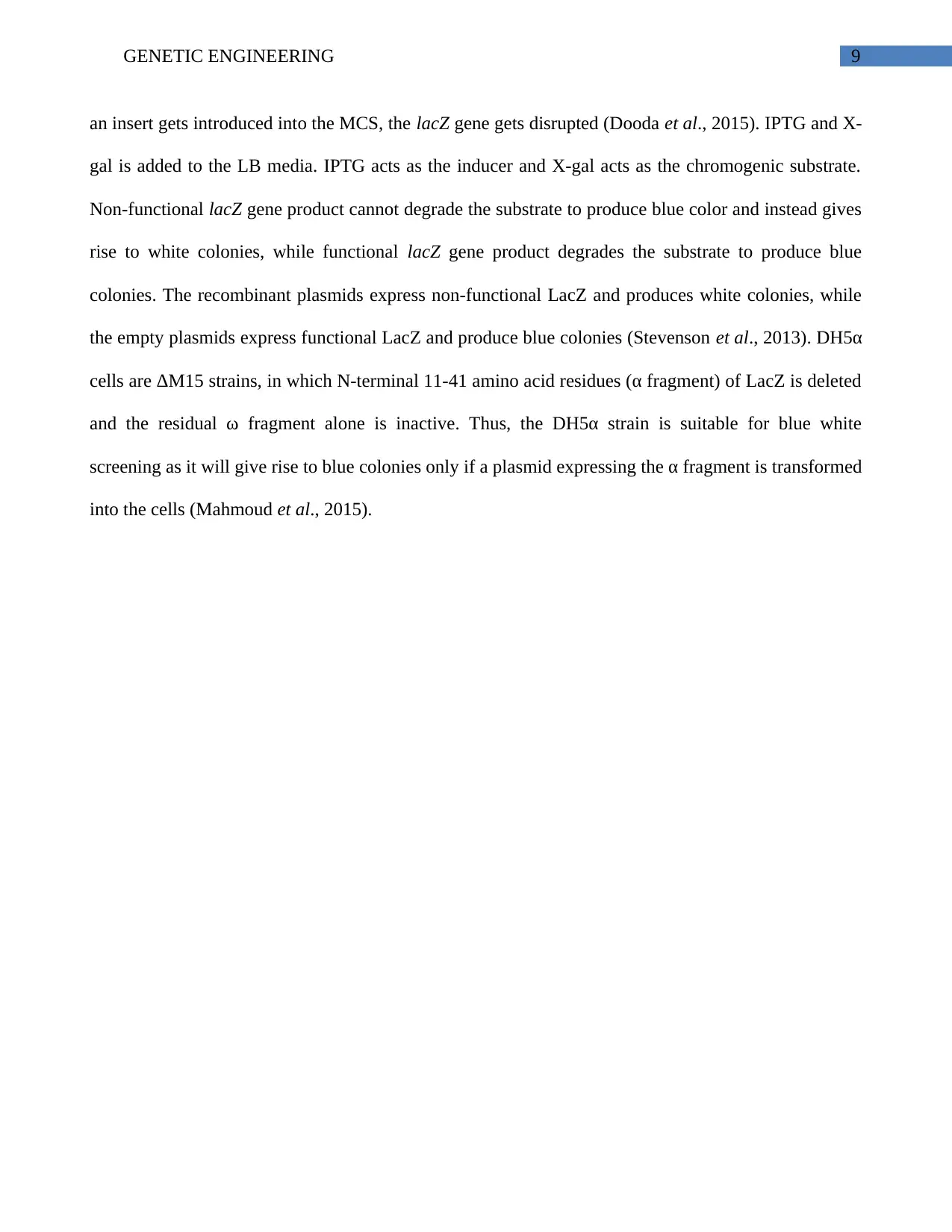
9GENETIC ENGINEERING
an insert gets introduced into the MCS, the lacZ gene gets disrupted (Dooda et al., 2015). IPTG and X-
gal is added to the LB media. IPTG acts as the inducer and X-gal acts as the chromogenic substrate.
Non-functional lacZ gene product cannot degrade the substrate to produce blue color and instead gives
rise to white colonies, while functional lacZ gene product degrades the substrate to produce blue
colonies. The recombinant plasmids express non-functional LacZ and produces white colonies, while
the empty plasmids express functional LacZ and produce blue colonies (Stevenson et al., 2013). DH5α
cells are ΔM15 strains, in which N-terminal 11-41 amino acid residues (α fragment) of LacZ is deleted
and the residual ω fragment alone is inactive. Thus, the DH5α strain is suitable for blue white
screening as it will give rise to blue colonies only if a plasmid expressing the α fragment is transformed
into the cells (Mahmoud et al., 2015).
an insert gets introduced into the MCS, the lacZ gene gets disrupted (Dooda et al., 2015). IPTG and X-
gal is added to the LB media. IPTG acts as the inducer and X-gal acts as the chromogenic substrate.
Non-functional lacZ gene product cannot degrade the substrate to produce blue color and instead gives
rise to white colonies, while functional lacZ gene product degrades the substrate to produce blue
colonies. The recombinant plasmids express non-functional LacZ and produces white colonies, while
the empty plasmids express functional LacZ and produce blue colonies (Stevenson et al., 2013). DH5α
cells are ΔM15 strains, in which N-terminal 11-41 amino acid residues (α fragment) of LacZ is deleted
and the residual ω fragment alone is inactive. Thus, the DH5α strain is suitable for blue white
screening as it will give rise to blue colonies only if a plasmid expressing the α fragment is transformed
into the cells (Mahmoud et al., 2015).
Secure Best Marks with AI Grader
Need help grading? Try our AI Grader for instant feedback on your assignments.
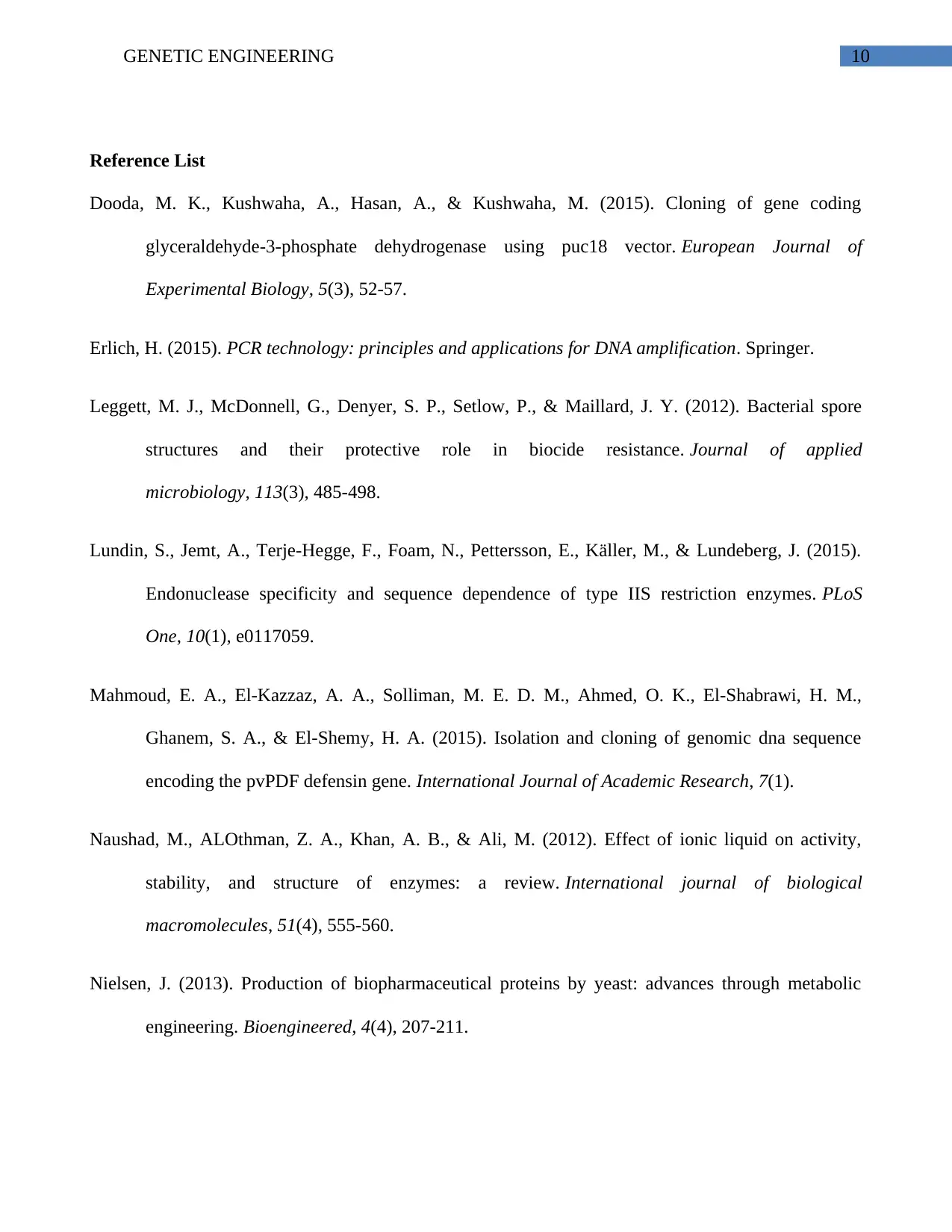
10GENETIC ENGINEERING
Reference List
Dooda, M. K., Kushwaha, A., Hasan, A., & Kushwaha, M. (2015). Cloning of gene coding
glyceraldehyde-3-phosphate dehydrogenase using puc18 vector. European Journal of
Experimental Biology, 5(3), 52-57.
Erlich, H. (2015). PCR technology: principles and applications for DNA amplification. Springer.
Leggett, M. J., McDonnell, G., Denyer, S. P., Setlow, P., & Maillard, J. Y. (2012). Bacterial spore
structures and their protective role in biocide resistance. Journal of applied
microbiology, 113(3), 485-498.
Lundin, S., Jemt, A., Terje-Hegge, F., Foam, N., Pettersson, E., Käller, M., & Lundeberg, J. (2015).
Endonuclease specificity and sequence dependence of type IIS restriction enzymes. PLoS
One, 10(1), e0117059.
Mahmoud, E. A., El-Kazzaz, A. A., Solliman, M. E. D. M., Ahmed, O. K., El-Shabrawi, H. M.,
Ghanem, S. A., & El-Shemy, H. A. (2015). Isolation and cloning of genomic dna sequence
encoding the pvPDF defensin gene. International Journal of Academic Research, 7(1).
Naushad, M., ALOthman, Z. A., Khan, A. B., & Ali, M. (2012). Effect of ionic liquid on activity,
stability, and structure of enzymes: a review. International journal of biological
macromolecules, 51(4), 555-560.
Nielsen, J. (2013). Production of biopharmaceutical proteins by yeast: advances through metabolic
engineering. Bioengineered, 4(4), 207-211.
Reference List
Dooda, M. K., Kushwaha, A., Hasan, A., & Kushwaha, M. (2015). Cloning of gene coding
glyceraldehyde-3-phosphate dehydrogenase using puc18 vector. European Journal of
Experimental Biology, 5(3), 52-57.
Erlich, H. (2015). PCR technology: principles and applications for DNA amplification. Springer.
Leggett, M. J., McDonnell, G., Denyer, S. P., Setlow, P., & Maillard, J. Y. (2012). Bacterial spore
structures and their protective role in biocide resistance. Journal of applied
microbiology, 113(3), 485-498.
Lundin, S., Jemt, A., Terje-Hegge, F., Foam, N., Pettersson, E., Käller, M., & Lundeberg, J. (2015).
Endonuclease specificity and sequence dependence of type IIS restriction enzymes. PLoS
One, 10(1), e0117059.
Mahmoud, E. A., El-Kazzaz, A. A., Solliman, M. E. D. M., Ahmed, O. K., El-Shabrawi, H. M.,
Ghanem, S. A., & El-Shemy, H. A. (2015). Isolation and cloning of genomic dna sequence
encoding the pvPDF defensin gene. International Journal of Academic Research, 7(1).
Naushad, M., ALOthman, Z. A., Khan, A. B., & Ali, M. (2012). Effect of ionic liquid on activity,
stability, and structure of enzymes: a review. International journal of biological
macromolecules, 51(4), 555-560.
Nielsen, J. (2013). Production of biopharmaceutical proteins by yeast: advances through metabolic
engineering. Bioengineered, 4(4), 207-211.
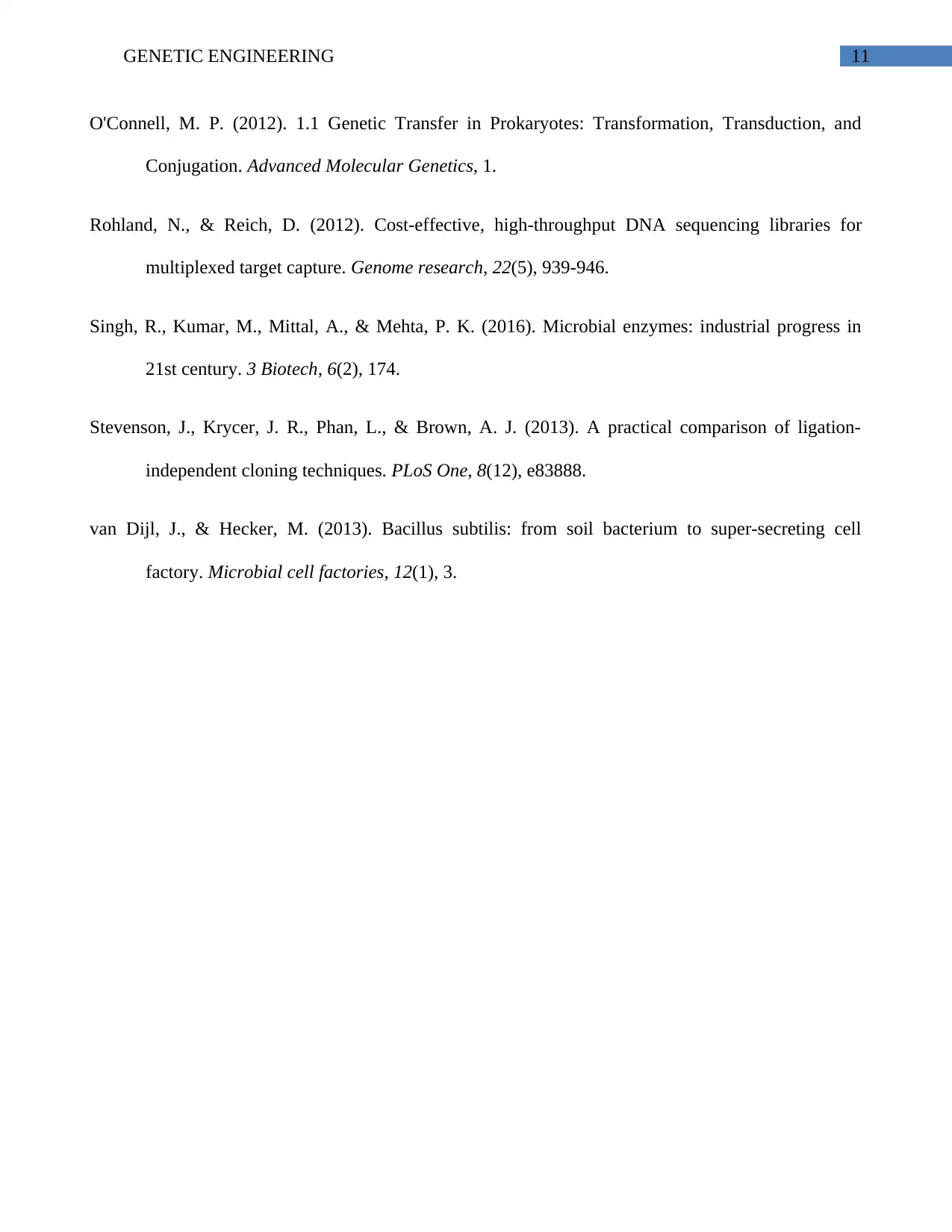
11GENETIC ENGINEERING
O'Connell, M. P. (2012). 1.1 Genetic Transfer in Prokaryotes: Transformation, Transduction, and
Conjugation. Advanced Molecular Genetics, 1.
Rohland, N., & Reich, D. (2012). Cost-effective, high-throughput DNA sequencing libraries for
multiplexed target capture. Genome research, 22(5), 939-946.
Singh, R., Kumar, M., Mittal, A., & Mehta, P. K. (2016). Microbial enzymes: industrial progress in
21st century. 3 Biotech, 6(2), 174.
Stevenson, J., Krycer, J. R., Phan, L., & Brown, A. J. (2013). A practical comparison of ligation-
independent cloning techniques. PLoS One, 8(12), e83888.
van Dijl, J., & Hecker, M. (2013). Bacillus subtilis: from soil bacterium to super-secreting cell
factory. Microbial cell factories, 12(1), 3.
O'Connell, M. P. (2012). 1.1 Genetic Transfer in Prokaryotes: Transformation, Transduction, and
Conjugation. Advanced Molecular Genetics, 1.
Rohland, N., & Reich, D. (2012). Cost-effective, high-throughput DNA sequencing libraries for
multiplexed target capture. Genome research, 22(5), 939-946.
Singh, R., Kumar, M., Mittal, A., & Mehta, P. K. (2016). Microbial enzymes: industrial progress in
21st century. 3 Biotech, 6(2), 174.
Stevenson, J., Krycer, J. R., Phan, L., & Brown, A. J. (2013). A practical comparison of ligation-
independent cloning techniques. PLoS One, 8(12), e83888.
van Dijl, J., & Hecker, M. (2013). Bacillus subtilis: from soil bacterium to super-secreting cell
factory. Microbial cell factories, 12(1), 3.
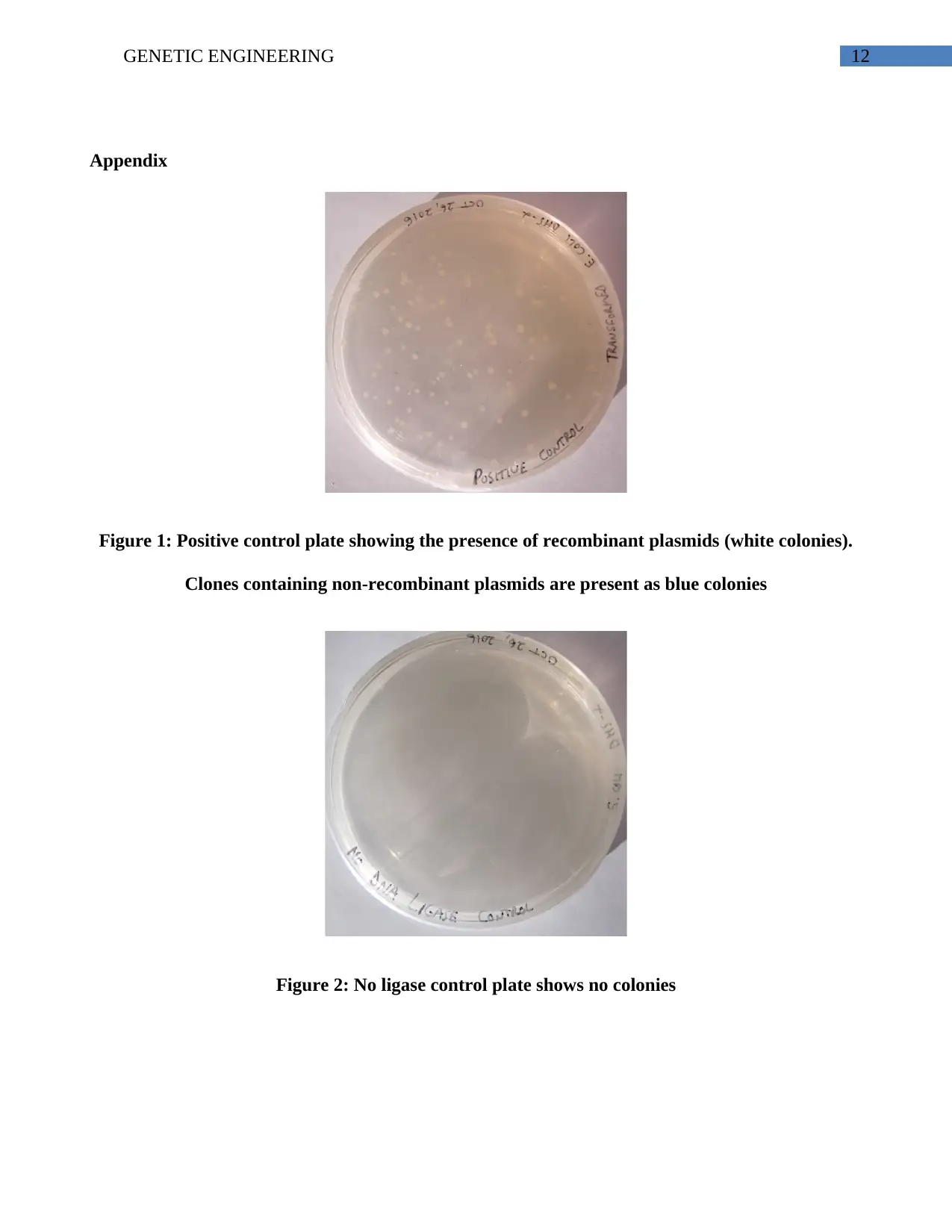
12GENETIC ENGINEERING
Appendix
Figure 1: Positive control plate showing the presence of recombinant plasmids (white colonies).
Clones containing non-recombinant plasmids are present as blue colonies
Figure 2: No ligase control plate shows no colonies
Appendix
Figure 1: Positive control plate showing the presence of recombinant plasmids (white colonies).
Clones containing non-recombinant plasmids are present as blue colonies
Figure 2: No ligase control plate shows no colonies
Paraphrase This Document
Need a fresh take? Get an instant paraphrase of this document with our AI Paraphraser
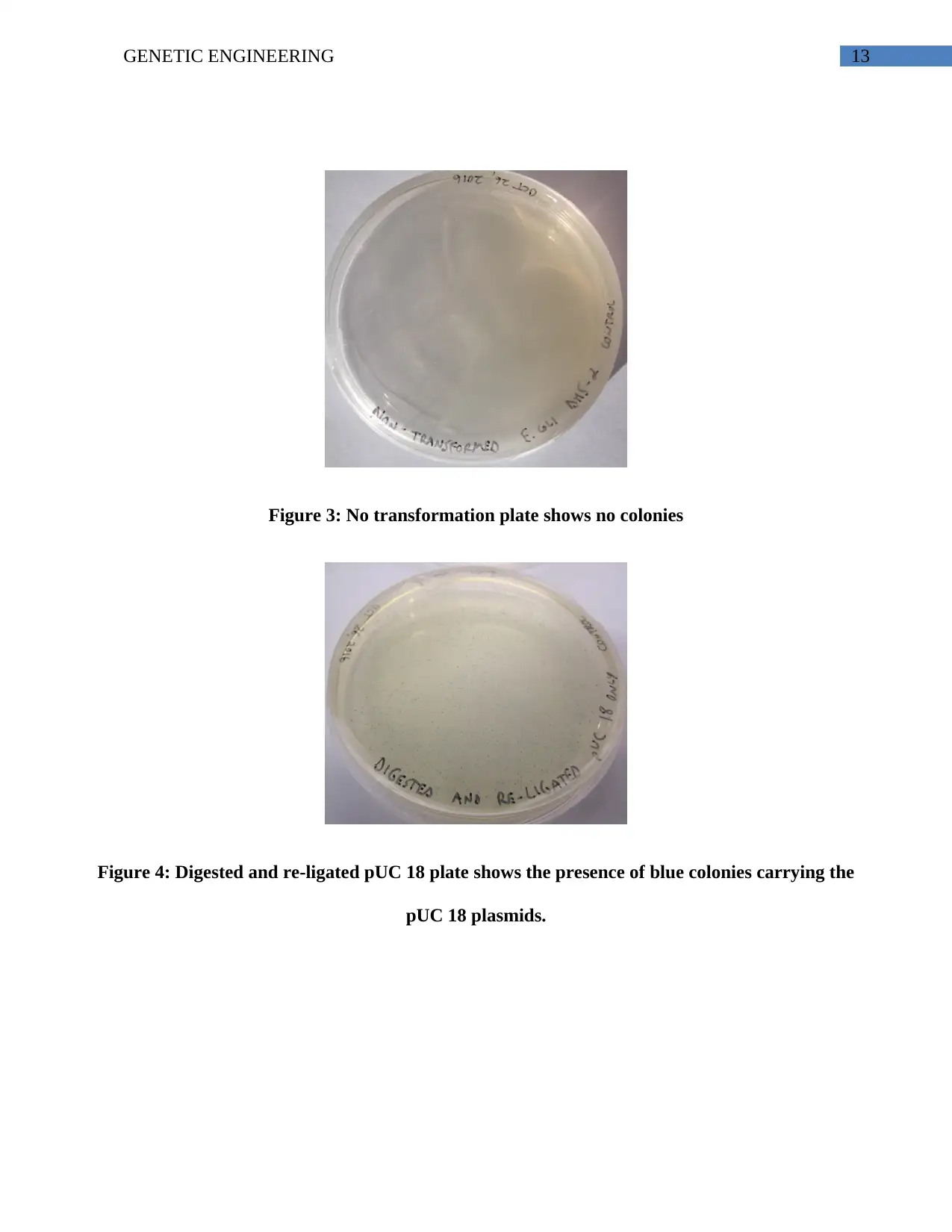
13GENETIC ENGINEERING
Figure 3: No transformation plate shows no colonies
Figure 4: Digested and re-ligated pUC 18 plate shows the presence of blue colonies carrying the
pUC 18 plasmids.
Figure 3: No transformation plate shows no colonies
Figure 4: Digested and re-ligated pUC 18 plate shows the presence of blue colonies carrying the
pUC 18 plasmids.

14GENETIC ENGINEERING
Figure 5: Control gel sample
Figure 6: Experimental gel sample
DNA
Ladder
Uncut
pUC 18
Double
digested
pUC 18
Genomic
DNA
Uncut
control
recombin
ant
plasmid
Single
digested
control
recombin
ant
plasmid
Double
digested
control
recombin
ant
plasmid
10000
8000
6000
5000
4000
3000
2500
2000
1500
1000
900
800
700
600
500
400
300
200
100
Double
digested
recombi
nant
plasmid
DNA
Ladder
Genomic
DNA
Uncut
recom
binant
plasmi
d
Single
digest
ed
recom
binant
plasmi
d
10000
8000
6000
5000
4000
3000
2500
2000
1500
1000
900
800
700
600
500
400
300
200
100
Figure 5: Control gel sample
Figure 6: Experimental gel sample
DNA
Ladder
Uncut
pUC 18
Double
digested
pUC 18
Genomic
DNA
Uncut
control
recombin
ant
plasmid
Single
digested
control
recombin
ant
plasmid
Double
digested
control
recombin
ant
plasmid
10000
8000
6000
5000
4000
3000
2500
2000
1500
1000
900
800
700
600
500
400
300
200
100
Double
digested
recombi
nant
plasmid
DNA
Ladder
Genomic
DNA
Uncut
recom
binant
plasmi
d
Single
digest
ed
recom
binant
plasmi
d
10000
8000
6000
5000
4000
3000
2500
2000
1500
1000
900
800
700
600
500
400
300
200
100
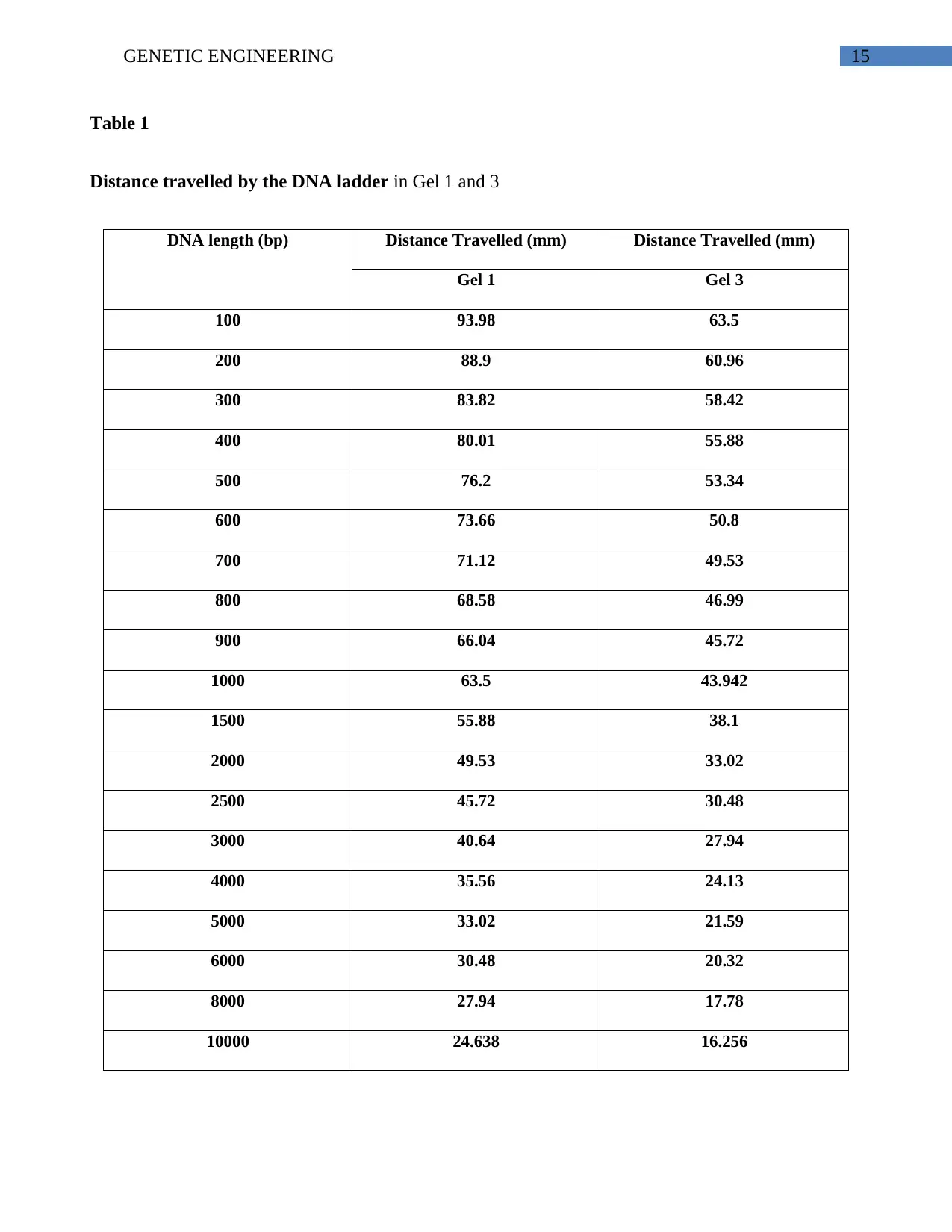
15GENETIC ENGINEERING
Table 1
Distance travelled by the DNA ladder in Gel 1 and 3
DNA length (bp) Distance Travelled (mm) Distance Travelled (mm)
Gel 1 Gel 3
100 93.98 63.5
200 88.9 60.96
300 83.82 58.42
400 80.01 55.88
500 76.2 53.34
600 73.66 50.8
700 71.12 49.53
800 68.58 46.99
900 66.04 45.72
1000 63.5 43.942
1500 55.88 38.1
2000 49.53 33.02
2500 45.72 30.48
3000 40.64 27.94
4000 35.56 24.13
5000 33.02 21.59
6000 30.48 20.32
8000 27.94 17.78
10000 24.638 16.256
Table 1
Distance travelled by the DNA ladder in Gel 1 and 3
DNA length (bp) Distance Travelled (mm) Distance Travelled (mm)
Gel 1 Gel 3
100 93.98 63.5
200 88.9 60.96
300 83.82 58.42
400 80.01 55.88
500 76.2 53.34
600 73.66 50.8
700 71.12 49.53
800 68.58 46.99
900 66.04 45.72
1000 63.5 43.942
1500 55.88 38.1
2000 49.53 33.02
2500 45.72 30.48
3000 40.64 27.94
4000 35.56 24.13
5000 33.02 21.59
6000 30.48 20.32
8000 27.94 17.78
10000 24.638 16.256
Secure Best Marks with AI Grader
Need help grading? Try our AI Grader for instant feedback on your assignments.
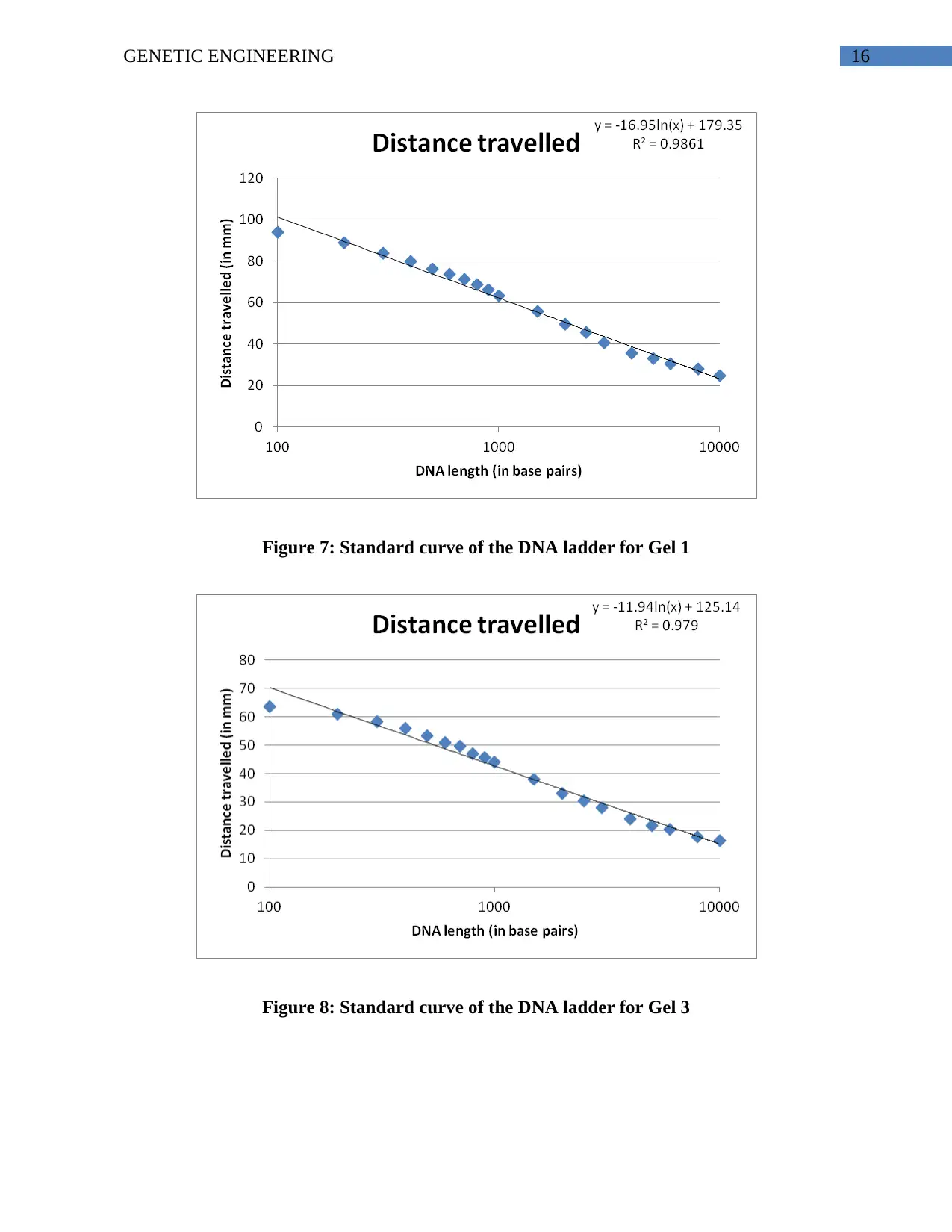
16GENETIC ENGINEERING
Figure 7: Standard curve of the DNA ladder for Gel 1
Figure 8: Standard curve of the DNA ladder for Gel 3
Figure 7: Standard curve of the DNA ladder for Gel 1
Figure 8: Standard curve of the DNA ladder for Gel 3
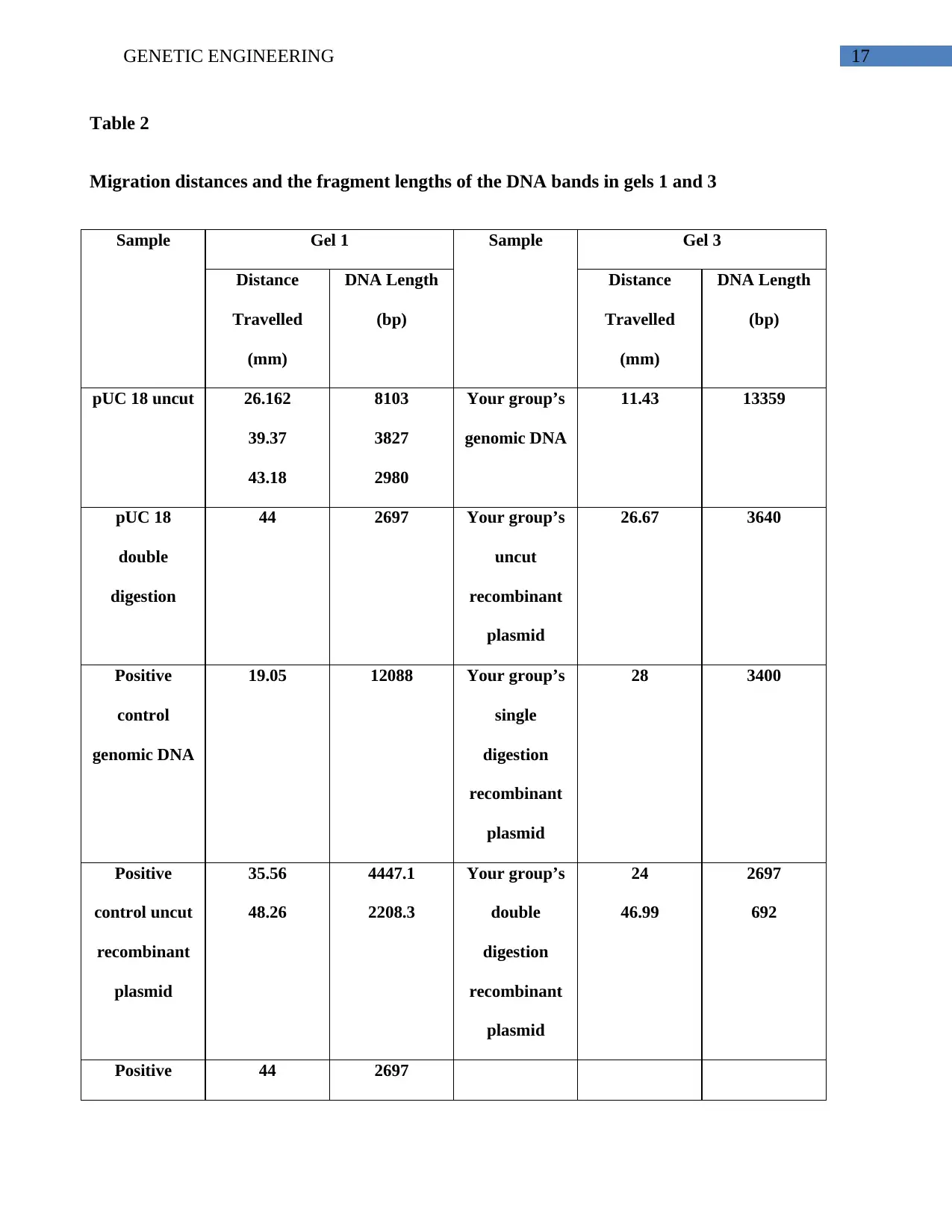
17GENETIC ENGINEERING
Table 2
Migration distances and the fragment lengths of the DNA bands in gels 1 and 3
Sample Gel 1 Sample Gel 3
Distance
Travelled
(mm)
DNA Length
(bp)
Distance
Travelled
(mm)
DNA Length
(bp)
pUC 18 uncut 26.162
39.37
43.18
8103
3827
2980
Your group’s
genomic DNA
11.43 13359
pUC 18
double
digestion
44 2697 Your group’s
uncut
recombinant
plasmid
26.67 3640
Positive
control
genomic DNA
19.05 12088 Your group’s
single
digestion
recombinant
plasmid
28 3400
Positive
control uncut
recombinant
plasmid
35.56
48.26
4447.1
2208.3
Your group’s
double
digestion
recombinant
plasmid
24
46.99
2697
692
Positive 44 2697
Table 2
Migration distances and the fragment lengths of the DNA bands in gels 1 and 3
Sample Gel 1 Sample Gel 3
Distance
Travelled
(mm)
DNA Length
(bp)
Distance
Travelled
(mm)
DNA Length
(bp)
pUC 18 uncut 26.162
39.37
43.18
8103
3827
2980
Your group’s
genomic DNA
11.43 13359
pUC 18
double
digestion
44 2697 Your group’s
uncut
recombinant
plasmid
26.67 3640
Positive
control
genomic DNA
19.05 12088 Your group’s
single
digestion
recombinant
plasmid
28 3400
Positive
control uncut
recombinant
plasmid
35.56
48.26
4447.1
2208.3
Your group’s
double
digestion
recombinant
plasmid
24
46.99
2697
692
Positive 44 2697
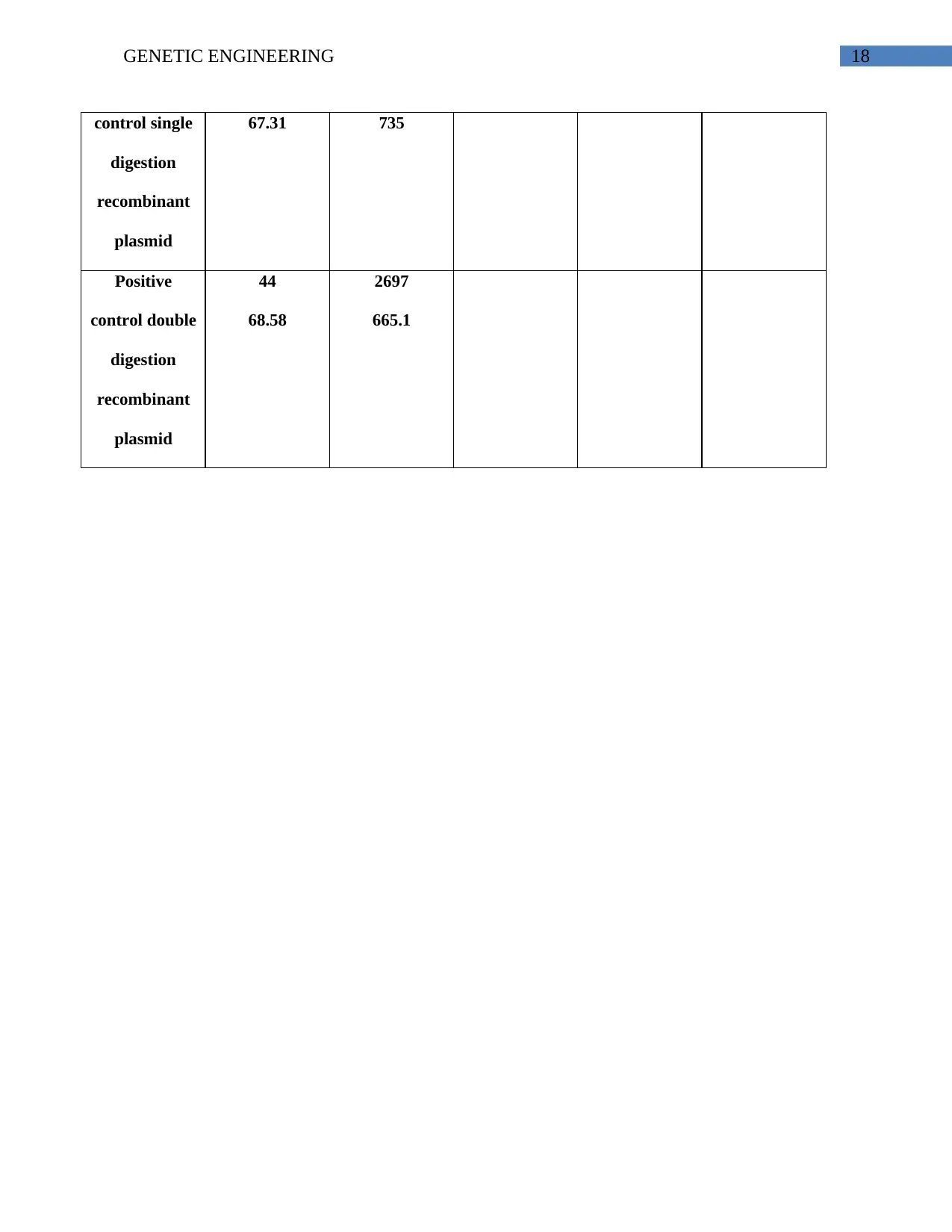
18GENETIC ENGINEERING
control single
digestion
recombinant
plasmid
67.31 735
Positive
control double
digestion
recombinant
plasmid
44
68.58
2697
665.1
control single
digestion
recombinant
plasmid
67.31 735
Positive
control double
digestion
recombinant
plasmid
44
68.58
2697
665.1
1 out of 19
Related Documents
Your All-in-One AI-Powered Toolkit for Academic Success.
+13062052269
info@desklib.com
Available 24*7 on WhatsApp / Email
![[object Object]](/_next/static/media/star-bottom.7253800d.svg)
Unlock your academic potential
© 2024 | Zucol Services PVT LTD | All rights reserved.





